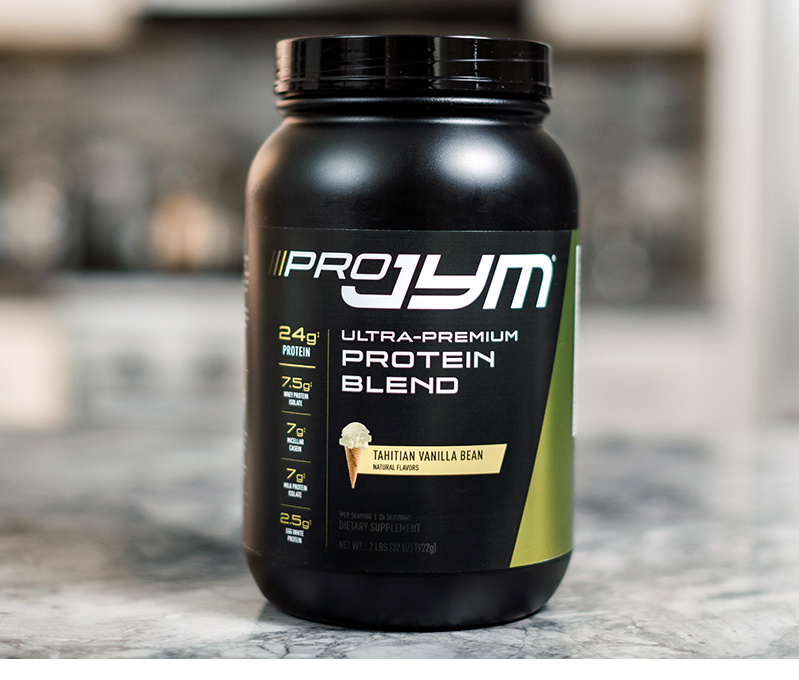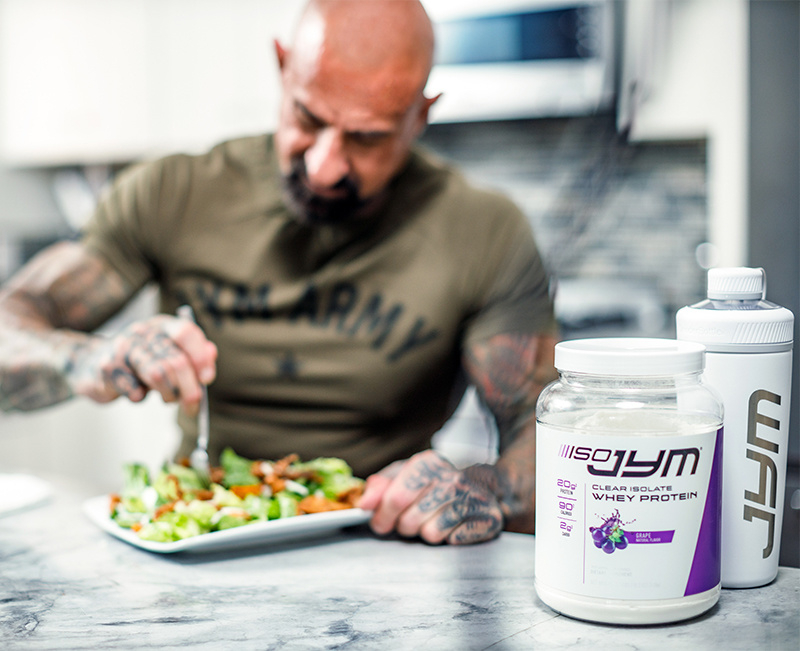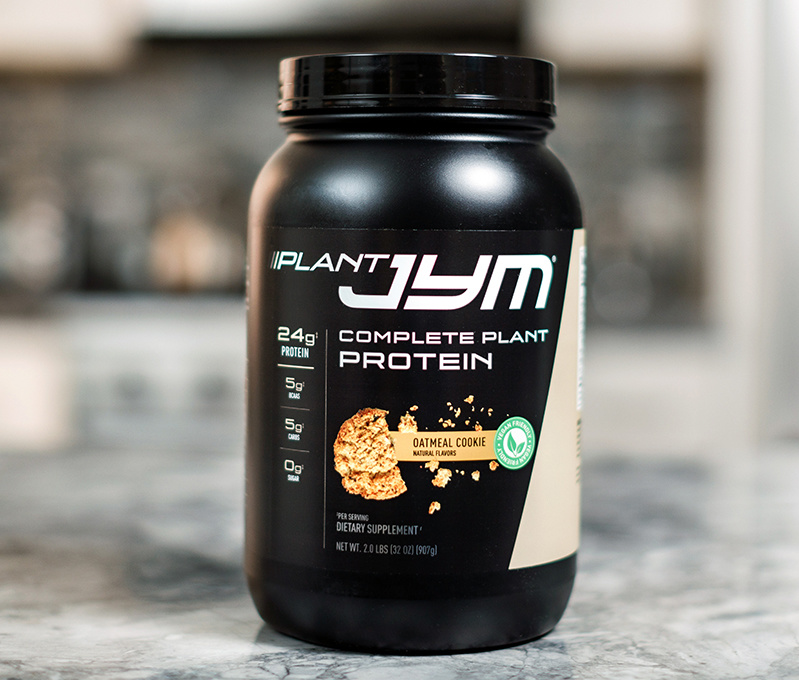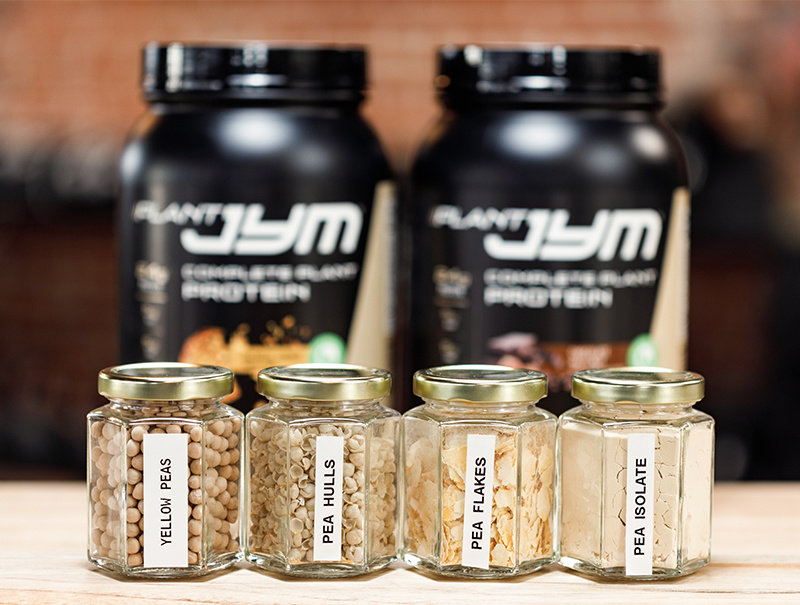Protein Powder Users Guide
Your guide to figuring out which protein powders to use based on your individual needs and goals, and how and when to take them.

Your guide to figuring out which protein powders to use based on your individual needs and goals, and how and when to take them.

It’s easy to get confused by all the different protein powders available to you. What type of protein should I use? Whey, a blend, or plant-based? How much should I take? When do I take it? What do I mix it with? What if I have food allergies or specific dietary needs?
I answer all these questions in the below users’ guide, which I created after launching my Iso JYM and Plant JYM products. Now that I offer three different protein powders (Pro JYM being the other), here’s how to decide which ones to use and how to use them to get bigger, stronger, and leaner.
My recommendation for protein intake is to consume a minimum of 1 gram of protein per pound of body weight, and closer 1.5 grams of protein per pound of bodyweight per day. High protein intake at these levels has been shown in numerous scientific studies to be ideal for both muscle-building and fat loss. Research has shown that even 2 grams per pound per day will keep your muscle gains lean.
For a 200-pound individual, 1.5 grams per pound is 300 grams of protein per day. And even the bare minimum recommendation of 1 gram per pound is 200 grams daily.
Two-hundred-plus grams of protein a day – that’s a lot, and it’s difficult to eat that much protein only through whole foods like meat and eggs. Not only is that a lot of eating, but if you consume enough whole foods to provide 300 grams of protein, you’re probably over-consuming on fat, and maybe carbs too.
This is why protein powder is crucial for just about anyone following a high-protein diet that keeps fat and carbs at appropriate levels and doesn’t require around-the-clock eating.
Getting in a majority of protein through whole foods, and then taking at least a couple scoops of protein powder per day to hit protein goals, is a common practice among athletes, bodybuilders, and those who train consistently in the gym for lofty physique goals. It’s even typical to get up to 100 grams of protein per day though protein powder – that’s what I’ve done for decades.
At the very least, anyone who trains seriously should be taking protein powder around workouts. As great as whole foods like beef, chicken, fish, and eggs are for high-quality protein, protein powders are more effective in the training window.
Muscles that have been exhausted from a recent training session need amino acids delivered ASAP to start the recovery process. With whole foods, it takes a long time for the proteins to be broken down into aminos. With protein powder, this process happens much quicker to boost muscle protein synthesis and start repairing and building muscle tissue.
I generally recommend taking 40-60 grams of protein powder around workouts. This could be 20 grams before and 20-40 grams after training, or 40-60 grams sipped on before and during your workout.
In this guide, I’ll be focusing on three main categories of protein powders, featuring the corresponding JYM product in each section:
For each type of protein powder, I’ll explain the following points in detail:

The general term “protein blend” can refer to any product that contains more than one type of protein. When I discuss protein blends, I’m usually referring to my Pro JYM premium protein blend, which contains three different types of protein: whey, casein, and egg.
For a protein powder to be considered a blend, the proteins need to be distinct types. Whey and casein both come from dairy, but they’re different types of proteins. And, obviously, egg is a different type of protein than whey or casein.
A protein powder that contains different types of whey protein is not a blend. There are, in fact, different types of whey proteins – whey protein isolate (WPI), whey protein concentrate (WPC), and whey protein hydrolysate (WPH) are the three main types. (In the below “Whey-Only Protein Powders” section, I’ll get into why WPI is the only type of whey I use in my products.) A product containing all three of these whey types, however, is technically not a blend if it doesn’t include any non-whey proteins. WPI, WPC, and WPH are processed differently, but they’re all whey proteins.
That said, whey/casein/egg isn’t the only type of protein blend; my vegan-friendly Plant JYM is a protein blend because it contains two different sources of protein (pea and rice). Yet while whey/casein/egg is far from the only protein blend on the market, it’s been shown through scientific research to be the most effective for optimizing muscle protein synthesis (MPS) and boosting muscle growth.
The reason whey, casein, and egg are such a potent blend for a protein powder is because all three digest at different speeds in the body. Whey is very fast absorbing, casein is very slow absorbing, and egg falls in the middle as a medium-absorbing protein.
Numerous research studies have shown that taking fast- and slow-digesting proteins at the same time not only spikes MPS in the short term (thanks to the whey), but it also keeps MPS elevated for extended periods of time (thanks to casein). There’s also scientific evidence showing that adding a medium-digesting protein (like egg) to the mix may be even better for growing muscle.
Read more about the research on protein blends in this Protein Blends article.
One other protein type worth mentioning here is milk protein, of which there are two main types found in protein powders: milk protein isolate (MPI) and milk protein concentrate (MPC). MPI is found in Pro JYM, so that’s the one I’ll discuss here. (I don’t use MPC for the same reason I don’t use WPC; more on that in the next section.)
MPI comes from extracting the whey and casein proteins out of powdered skim milk. This is why I don’t always mention MPI as its own protein type – because it’s really just whey and casein.
MPI has roughly the same ratio of casein to whey as milk itself (around 80% casein, 20% whey). There’s nothing inherently wrong with this ratio, but the research shows that a protein powder with a more even ratio of whey to casein is better for optimizing MPS and is thus more anabolic.
Based on the science, Pro JYM is made up of 50% casein, 40% whey, and 10% egg protein – an ideal ratio of slow- to fast- to medium-digesting protein sources for spiking MPS and keeping it elevated for a relatively long period of time.
Pro JYM is an ideal protein powder for anyone who wants to maximize lean muscle growth and strength and doesn’t have any intolerances or allergies to dairy or eggs.
Yet even though Pro JYM contains dairy proteins (whey and casein), it contains 0 grams of lactose. Because of this, you should still be able to use Pro JYM and experience no stomach issues even if you’re lactose sensitive or intolerant.
Pro JYM can literally be taken any time of day. After all, it’s food! Regular Pro JYM users drink it first thing in the morning; as snacks between meals; with meals that are otherwise low in protein; around workouts (before, during, after training); and/or right before bedtime.
To be more specific, the times Pro JYM is truly the most beneficial, as compared to other protein products, are around workouts and before bedtime.
When you train, you break down muscle protein. If you don’t replace that muscle protein, you go into what’s called a negative net protein balance (or deficit). If you’re at a muscle protein deficit, MPS (the process of building muscle) is not taking place. This is why it’s so important to take protein around workouts – because this is when you’ll be breaking down muscle protein and possibly going into a negative net protein balance.
The whey protein in Pro JYM will get to your muscle extremely fast to get you out of the deficit and ignite MPS. But because whey is so fast, the MPS spike it creates is short-lived. That’s where the egg (medium-digesting) and casein (slow-digesting) come in. After the whey has been taken up completely, the muscles can continue to get amino acids from the egg and casein proteins for hours to come, which can potentially lead to greater muscle growth.
I recommend taking 2-3 scoops of Pro JYM around workouts, and this can be done in a number of ways. You can take 1 scoop around 30 minutes before your workout, then 1-2 scoops within 30 minutes after your workout. Or, you can mix 2-3 scoops of Pro JYM, start sipping it before your workout, and continue sipping it during your workout. If you opt for this before/during approach, you don’t have to take Pro JYM after the workout.
Whichever way you decide is fine. The important thing is that you’re feeding your muscles the protein during your training window.
When it comes to bedtime, Pro JYM really shines due to its micellar casein content. As mentioned earlier, casein is very slow absorbing. And since you’ll be sleep for many hours straight (and not eating anything), taking casein will essentially allow your muscles to be “fed” amino acids while you’re in bed.
My bedtime recommendation is to take 1-2 scoops of Pro JYM as close to going to sleep as possible.
You won’t find a better tasting protein powder than Pro JYM, and it comes in a number of delicious flavors. I’m always looking to add new flavors, and certain ones are seasonal/limited, but some of the most popular Pro JYM flavors are:

What we’re talking about in this category are products that contain only whey protein, even if some of them include multiple types of whey (for example, a protein powder that includes whey protein isolate, concentrate, and hydrolysate).
I’ll focus mainly here on whey protein (WPI) versus whey protein concentrate (WPC), as these are the two most common types of whey found in protein powders – and there’s a big difference between the two. Whey protein hydrolysate (WPH) is effectively “pre-digested,” and thus even faster digesting than WPI – arguably too fast. WPH is also more expensive than WPI, and in my opinion not worth the extra money since WPI is fast enough in its own right.
I’ll be very clear. I use only whey protein isolate (WPI) in my protein powders, and none of my products contain whey protein concentrate (WPC). There are two main reason for this: (1) WPI contains more protein than WPC, and (2) WPC contains more lactose than WPI.
When WPI is made, the end product is almost entirely protein (at least 90%, usually more). Not protein plus a bunch of carbs and fat – basically just protein. With WPC, you’re getting protein, but you’re also getting significant amounts of carbs and fat. At best, a scoop of WPC is 80% protein, with the rest being carbs and fat; but in some cases, WPC is made up of as little as 35% protein!
Plus the extra carbs we’re talking about here is lactose, which the majority of adults have issues with. If you have stomach issues, like gas, bloating, or diarrhea from your whey protein powder, check the ingredients list, as it likely uses whey protein concentrate, and is therefore loaded with lactose. All JYM protein powders have zero lactose, so that they’re easier to digest.
Not only are you getting skimped on protein, and getting a boatload of problematic lactose, but the extra carbs and fat can also lead to unwanted fat gain instead of just pure lean muscle. When you buy a protein powder, you want it to be pure protein, with minimal carbs and fat.
So, why do companies use WPC in their protein powders rather than WPI? Because WPC is cheaper, which makes their profit margins higher. For the end consumer, you get what you pay for. And with WPC, you’re paying good money for a lot of carbs and fat.
With WPI, the whey protein is literally “isolated” from the carbs and fat you don’t want. That’s why WPI is the only type of whey I use in my protein powders, and even my JYM Bar.
Look at the nutrition facts of 1 scoop of Iso JYM (appropriately named because it’s pure whey protein isolate): 20 grams of protein, 0 grams of fat, and only 1 gram of carbs.
Iso JYM is an ideal protein for individuals looking for a high-quality, whey-only product. It’s also great for anyone wanting thirst-quenching flavors, yet with none of the sugar you get from most beverages. This is pure protein for lean muscle gains!
Iso JYM is a go-to supplement for everyday use. It delivers the most protein per calorie when compared to protein powders that use protein concentrates or milk protein isolates, and it’s perfect to help meet your macros on protein without going over on carbs and fats.
Iso JYM is also a great choice for those who are lower if to other protein sources, like egg.
First thing in the morning and/or with whole food meals are great instances to take Iso JYM.
When you wake up, you’ve essentially been fasting for the past 8 hours or so. And if your primary goal is to build muscle, you’ll want your muscles to get refueled with amino acids as quickly as possible with no slowdowns. Iso JYM mixed with cold water will achieve this.
Taking WPI along with a whole food meal is a smart idea when you want to bump up the total protein content of a meal. Research suggests that to maximize muscle protein synthesis after a meal, the meal needs to provide a minimum of 3 grams of the amino acid leucine. It typically takes at least 40 grams of whole food protein to deliver that 3+ grams of leucine.

So, if a meal you’re having provides less than 40 grams of protein, you can bump up the total protein amount as well as the leucine amount (whey is rich in leucine) with a WPI shake.
All that said, there’s no bad time to take Iso JYM. If you’re like me and can’t use Pro JYM, but you still want a WPI product to take around workouts, Iso JYM is your best bet.
Granted, the research shows that a protein blend is best around workouts, but WPI on its own is still very effective. Iso JYM is what I use every day for my pre-, during, and post-workout protein source. If I could use Pro JYM around workouts, I probably would. But I have no choice, and I love Iso JYM, so no complaints here!
Iso JYM is different than Pro JYM in that its flavors are light, fruity, and refreshing. It’s very thirst quenching – like Gatorade with an added 20 grams of WPI! I’ll likely be adding new flavors in the future, but current Iso JYM flavors include:

Plant-based protein powders are those that don’t contain any animal sources of protein (including dairy) – only plants. There are a number of different plant sources these proteins can come from, including peas, rice, hemp, almonds, and soy.
Two of the best sources of plant protein are peas and rice, and those are the two sources found in my vegan-friendly Plant JYM protein powder. Just like I only include whey protein isolates in Pro JYM and Iso JYM (no concentrates), the pea and rice proteins in Plant JYM are both isolates. Because of this, you’re getting maximum protein per scoop and minimal carbs and fat.
I further explain plant protein isolates versus concentrates in my How to Spot a Crappy Plant Protein Powder article.
The most often cited downside of plant proteins is that they’re not technically “complete proteins,” meaning they lack one or more of the essential amino acids (EAA) – whereas animal proteins have all EAAs and are thus complete. Three of those EAAs are branched-chain amino acids (BCAAs), which are critical for building muscle (leucine in particular).
Pea and rice are two of the closest plant proteins to being complete, with each being short only one EAA (methionine+cystine for pea, lysine for rice). This is why I chose these two proteins for Plant JYM – because of their favorable amino acid profiles. Using a blend of the two means that each can make up for the other’s EAA deficiency, since pea has sufficient methionine+cystine and rice has sufficient lycine.

To further bolster the EAA content of Plant JYM, I fortified it with additional vegan amino acids, including the EAAs pea and rice are lacking, plus BCAAs in the optimal 2:1:1 ratio of leucine to isoleucine to valine. By adding these EAAs, I essentially made the pea and rice proteins complete, while also making Plant JYM’s amino acid profile nearly identical to Pro JYM to deliver the same muscle-building results.
For more details on Plant JYM, read this Plant JYM article.
Plant JYM is the clear choice for people who want or need a non-dairy, non-animal-based protein powder. It’s ideal for anyone following a vegetarian or vegan lifestyle who trains hard in the gym and wants to build muscle. Plant JYM is also a great option for anyone who experiences GI or stomach discomfort from dairy-based protein powders like whey.
Other individuals who Plant JYM would work for are those who are gluten- or lactose-intolerant and/or want to avoid soy. But keep in mind, both Pro JYM and Iso JYM have 0 grams of lactose as well.
Yes, of course! Whether you eat meat and dairy or not, it’s always good to get a variety of plant-based foods in your diet, including plant proteins like pea and rice. As you probably know, plants offer many nutritional benefits, even if just taking the protein portion of them.
Plant JYM has essentially the same macronutrient and amino acid profile as Pro JYM, so it will be great for your muscles and your body whether you eat meat or dairy in addition to it or not.
Plant JYM can be used the exact same way, and at the same times of day, as Pro JYM – first thing in the morning; between meals; with meals that are low in protein; around workouts (before, during, after training); and/or at bedtime.
I formulated Plant JYM to mirror the macros and aminos of Pro JYM so that people could use it either in place of Pro JYM or interchangeably. If you want a protein powder you can take around workouts as well as at other times of day, but it needs to be non-dairy-sourced and plant-based, use Plant JYM.
However, if you want to use both a whey/egg-based protein blend and a plant-based protein, alternate between Pro JYM and Plant JYM. Pro JYM is probably the slightly better option before bedtime, due to the slow-digesting casein, but Plant JYM’s proteins (pea and rice) are both medium-digesting and would work at this time as well.
Plant JYM is not only the best-tasting plant protein powder on the market; it’s as delicious as any protein powder, period, including Pro JYM. I’ll likely be adding new flavors in the future, but Plant JYM’s flagship flavors are:
Don’t feel like you have to choose just one JYM protein powder and stick with it. If you want (or need) to have something non-dairy, then go with Plant JYM exclusively. Otherwise, feel free to use all three different JYM proteins. You can even use all three in the same day. For example, Iso JYM first thing in the morning and/or with a meal; Plant JYM pre-workout; and Pro JYM post-workout as well as at bedtime.
Here's a quick reference guide showing which protein powders work best at different times of day:
Flavor and texture wise, Pro JYM and Plant JYM are best for when you want something thicker with a traditional milkshake flavor. At this point, Pro JYM offers more flavors than Plant JYM, so you have more options there. If you’re craving something light and refreshing, similar to a sports drink, go with Iso JYM and its fruity flavors.
As I've been saying for years, I design all of my products to be used together – and that includes my different protein powders.
Antonio, J., et al. The effects of a high protein diet on indices of health and body composition – a crossover trial in resistance-trained men. Int Soc Sports Nutr 13:3, 2016.
Bosse, J. D. and Dixon, B. M. Dietary protein to maximize resistance training: a review and examination of protein spread and change theories. J Int Soc Sports Nutr. 2012 Sep 8;9(1):42.
Burke, D. G, et al. The effect of whey protein supplementation with and without creatine monohydrate combined with resistance training on lean tissue mass and muscle strength. Int J Sport Nutr Exerc Metab 2001, 11:349–364.
Candow, D. G., et al. Effect of whey and soy protein supplementation combined with resistance training in young adults. Int J Sport Nutr Exerc Metab 2006, 16:233–244.
Cribb, P. J., et al. Effects of whey isolate, creatine, and resistance training on muscle hypertrophy. Med Sci Sports Exerc. 2007 Feb;39(2):298-307.
Kerksick, C. M., et al. The effect of protein and amino acid supplementation in performance and training adaptations during ten weeks of resistance training. Journal of Strength and Conditioning Research 20(3), 643–653, 2006.
Longland, T. M., et al. Higher compared with lower dietary protein during an energy deficit combined with intense exercise promotes greater lean mass gain and fat mass loss: a randomized trial. The American Journal of Clinical Nutrition, in press, 2016.
Reidy, P. T., et al. Protein Blend Ingestion Following Resistance Exercise Promotes Human Muscle Protein Synthesis. Journal of Nutrition 143(4):410-416, 2013.
Reidy, P. T., et al. Soy-dairy protein blend and whey protein ingestion after resistance exercise increases amino acid transport and transporter expression in human skeletal muscle. Journal of Applied Physiology, In press, 2014.
Soop, M., et al. Coingestion of whey protein and casein in a mixed meal: demonstration of a more sustained anabolic effect of casein. Am J Physiol Endocrinol Metab. 303(1):E152-62, 2012.
Witard, O. C., et al. Effect of increased dietary protein on tolerance to intensified training. Med Sci Sports Exerc. 2011 Apr;43(4):598-607.
Related Articles